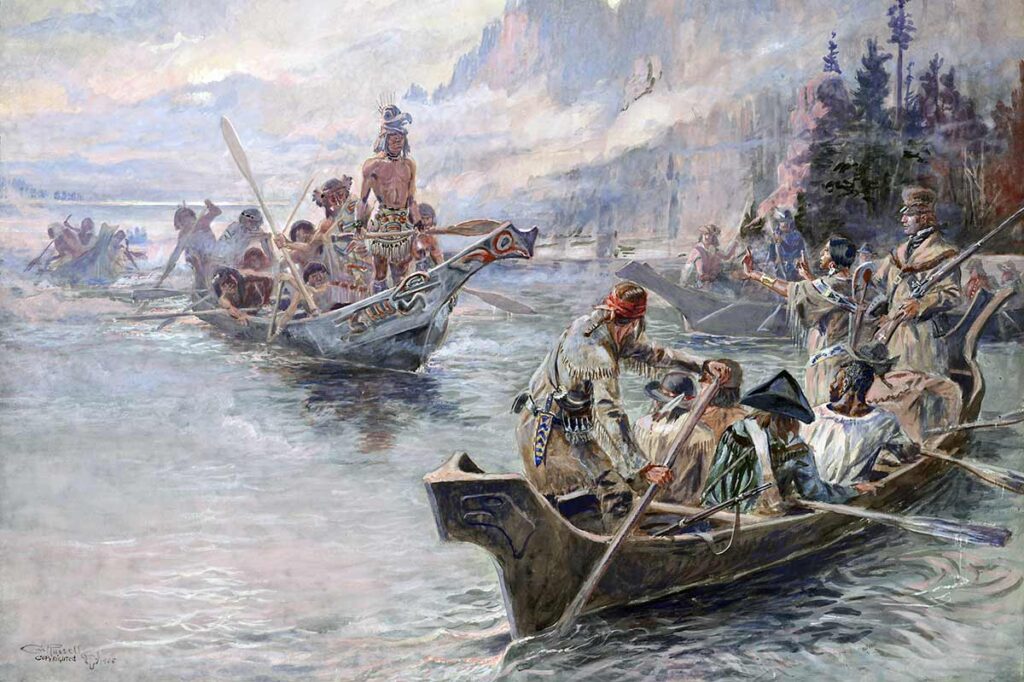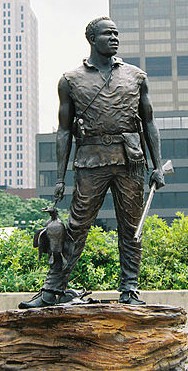York was an enslaved man who played an essential, yet historically underrepresented, role in the Lewis and Clark Expedition (1804-1806).

As the only Black member of the Corps of Discovery, York’s contributions ranged from his physical labor to his diplomatic interactions with Native American tribes.
Despite the significance of his involvement, York returned to a life of enslavement upon the expedition’s conclusion, receiving neither the accolades nor the rewards that his fellow expedition members were granted.
York’s Early Life and Connection to Louisville
Born around 1770 in Virginia, York was enslaved by the Clark family, likely growing up alongside William Clark, who would later become one of the leaders of the famous expedition. By the time the Clark family moved to Louisville, York was a young man and would have worked as a personal servant to William Clark. His life in Louisville placed him in the burgeoning frontier, a city that would play a significant role in the early westward expansion of the United States.
There is limited documentation on York’s early life in Louisville, but historians believe that his physical capabilities were likely honed during his time working in the city.
Louisville, in the early 19th century, was a key hub for the growing frontier economy, with its proximity to the Ohio River making it a crucial site for trade and migration. It was in Louisville that Clark was appointed to co-lead the expedition, and York, as his personal servant, would be taken along.
York’s Role in the Lewis and Clark Expedition
When the expedition embarked in 1804, York’s role was not merely that of a servant, he was expected to perform the same tasks as the other members of the Corps of Discovery. He carried out vital physical labor, helped navigate treacherous terrain, and participated in hunting for food. Importantly, York was also involved in the diplomatic efforts of the expedition, particularly in their interactions with Native American tribes.
York labors hard, and fully equal to the other men, and in some respects more so.
William Clark’s journal
The Native Americans the Corps encountered were often intrigued by York, having never seen a Black man before. William Clark’s journal entries mention the reactions of Native tribes, particularly their curiosity and respect for York. Clark wrote, “The black man York… was admired by the Indians, he was viewed as something mysterious.” This curiosity sometimes worked to the expedition’s advantage in negotiations and establishing peaceful relations.
During the winter of 1804 to 1805, the expedition stayed with the Mandan tribe, and York’s presence was particularly fascinating to them. According to Clark’s journals, York was treated with much respect, and some tribal members believed his skin color held spiritual significance. This attention helped the Corps maintain amicable relations with the Mandan and other tribes.
While York’s diplomatic presence was significant, his physical contributions were also crucial to the survival and success of the Corps. On numerous occasions, he helped secure food for the team during difficult stretches. According to historian Robert Betts, York’s “exceptional physical strength and hunting skills were repeatedly called upon, particularly during some of the more challenging stages of the journey.”
York’s Return to Enslavement After the Expedition
He has got such a notion about freedom and his wife… I do not expect that he will be of much service to me again.
William Clark in a letter to his brother
Unlike the other members of the Corps, who received payment and land grants for their service, York returned to the status of an enslaved man upon the expedition’s return in 1806. There are multiple accounts of York requesting his freedom from William Clark after the expedition, but Clark refused. Clark’s letters from this period reflect his frustration with York’s desire for autonomy. In an 1808 letter to his brother, Clark wrote, “He [York] is insolent and sulky… he has got such a notion about freedom and his wife.”
York’s desire for freedom was not just a yearning for autonomy but also a desire to reunite with his wife, who was enslaved in Louisville. Despite his service, York remained in bondage for nearly a decade after the expedition. There are conflicting reports about when, or even if, Clark eventually granted York his freedom. Some sources suggest that York was freed around 1815, but others imply that he may have remained enslaved longer. His life after the expedition remains somewhat murky, with some accounts suggesting he returned to Kentucky and others stating he may have traveled west again.
York’s Legacy and Statue in Louisville
For many years, York’s contributions to the Lewis and Clark Expedition were largely overlooked by mainstream historical accounts. However, in recent decades, efforts have been made to recognize his role in one of the most significant explorations in American history.
In Louisville, the city that shaped much of York’s early life, a statue was erected in his honor in downtown Louisville. The statue, created by sculptor Ed Hamilton, stand son Belvedere plaza and depicts York in a powerful stance, recognizing his role in the Corps of Discovery. It was dedicated on October 14, 2003, to honor him on the bicentennial of the expedition .

This statue serves as a tangible reminder of York’s contributions, as well as the broader legacy of enslaved individuals whose work often went unacknowledged or unrewarded. The statue is one of the few physical memorials dedicated to York and stands in contrast to the centuries of historical neglect he endured.
Over time, York’s story has also been included in academic works and exhibitions, such as those at the Filson Historical Society in Louisville, which seeks to preserve and share the history of Kentucky’s frontier.
Historians continue to uncover more about York’s life and his contributions to the Lewis and Clark Expedition. As new research sheds light on the nuanced role he played, York’s legacy grows as a representation of the unrecognized labor and sacrifices made by enslaved people in the expansion and development of the United States.
Speaking Only in Second-Hand Accounts
York himself did not leave behind a personal account or journal of his experiences, but historians have pieced together his role through the writings of others. William Clark’s journal provides the most direct evidence of York’s involvement, though the perspectives are filtered through Clark’s own views as a slave owner. Clark’s remark that “York labors hard, and fully equal to the other men” is a rare acknowledgment of York’s efforts, though it fails to capture the complexity of his position as an enslaved man.
Additionally, York’s own words about his desire for freedom, as mentioned by Clark in his letters, reveal his frustration at being denied the liberty he believed he had earned. York’s story is a reminder of the contradictions in the early history of the United States, where the ideals of freedom and exploration often existed alongside the realities of slavery and oppression.
